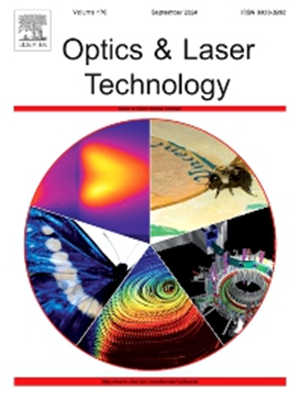Y3Fe5O12 陶瓷在中红外波长下的特性及其在法拉第隔离器中的应用
IF 5
2区 物理与天体物理
Q1 OPTICS
引用次数: 0
摘要
与常用的 1 μm 波长法拉第隔离器(FIs)相比,由于缺乏合适的磁光(MO)候选材料,现有的中红外 FIs 的性能仍然不能令人满意。在这项研究中,我们首次描述了一种基于 Y3Fe5O12(YIG)MO 陶瓷的新型中红外 FI。我们测试了通过热压烧结合成的 YIG 陶瓷的法拉第效应,并将其与商用 YIG 单晶和掺杂双铁石榴石 (BIG) 薄膜的法拉第效应进行了比较。结果表明,YIG 陶瓷在 2.1 微米处的法拉第旋转角为 114 度/厘米,在 3.8 微米处的法拉第旋转角为 60 度/厘米。基于 YIG 陶瓷的 FI 在 2.1 微米处的消光比为 25.26 dB,插入损耗为 1.01 dB,而基于 YIG 陶瓷的法拉第旋转器在 3.8 微米处的消光比为 28.30 dB,插入损耗为 1.17 dB。在高重复率脉冲激光辐射下,YIG 陶瓷和 YIG 晶体在相似的激光功率密度下都出现了表面损伤。考虑到 YIG 陶瓷的尺寸可扩展性,进一步提高 YIG 陶瓷的光学质量有望为实现高功率中红外光 FI 提供更优越的方法。本文章由计算机程序翻译,如有差异,请以英文原文为准。
Characteristics of Y3Fe5O12 ceramic at mid-infrared wavelengths and its Faraday isolator application
Compared to the commonly used 1 μm wavelength Faraday isolators (FIs), the performance of existing mid-infrared FIs remains unsatisfactory due to the lack of suitable magneto-optic (MO) candidate materials. In this study, we described a novel mid-infrared FI based on Y3Fe5O12 (YIG) MO ceramics for the first time. The Faraday effects of YIG ceramics synthesized by hot-press sintering were tested and compared with those of commercial YIG single crystals and Bi-doped iron garnet (BIG) films. Faraday rotation angles of 114 deg/cm at 2.1 µm and 60 deg/cm at 3.8 µm have been demonstrated in YIG ceramics. The YIG ceramic-based FI exhibited an extinction ratio of 25.26 dB and an insertion loss of 1.01 dB at 2.1 µm, while the YIG ceramic-based Faraday rotator showed an extinction ratio of 28.30 dB and an insertion loss of 1.17 dB at 3.8 µm. Under high repetition rate pulsed laser radiation, surface damage was observed for both the YIG ceramic and the YIG crystal at similar laser power densities. Given its size scalability, further improvement in the optical quality of YIG ceramic is expected to provide a superior approach for realizing high power mid-infrared FIs.
求助全文
通过发布文献求助,成功后即可免费获取论文全文。
去求助
来源期刊
CiteScore
8.50
自引率
10.00%
发文量
1060
审稿时长
3.4 months
期刊介绍:
Optics & Laser Technology aims to provide a vehicle for the publication of a broad range of high quality research and review papers in those fields of scientific and engineering research appertaining to the development and application of the technology of optics and lasers. Papers describing original work in these areas are submitted to rigorous refereeing prior to acceptance for publication.
The scope of Optics & Laser Technology encompasses, but is not restricted to, the following areas:
•development in all types of lasers
•developments in optoelectronic devices and photonics
•developments in new photonics and optical concepts
•developments in conventional optics, optical instruments and components
•techniques of optical metrology, including interferometry and optical fibre sensors
•LIDAR and other non-contact optical measurement techniques, including optical methods in heat and fluid flow
•applications of lasers to materials processing, optical NDT display (including holography) and optical communication
•research and development in the field of laser safety including studies of hazards resulting from the applications of lasers (laser safety, hazards of laser fume)
•developments in optical computing and optical information processing
•developments in new optical materials
•developments in new optical characterization methods and techniques
•developments in quantum optics
•developments in light assisted micro and nanofabrication methods and techniques
•developments in nanophotonics and biophotonics
•developments in imaging processing and systems

 求助内容:
求助内容: 应助结果提醒方式:
应助结果提醒方式:


